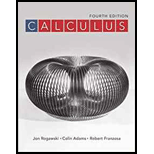
Find the average velocity and instantaneous velocity of the given particle.
Answer to Problem 1CRE
Solution:
Average velocity [2, 5] = 0.954 ms-1
Instantaneous velocity = 0.894 ms-1
Explanation of Solution
Given:
Formula used:
Calculation:
Displacement at t = 2
Conclusion:
To find the average velocity we can input values in the function and calculate the value. But when finding the instantaneous velocity we have to differentiate the displacement function and input the values.
Want to see more full solutions like this?
Chapter 2 Solutions
EBK CALCULUS
- Sup the is a -12 -10 -8 -6 -4 -2 16 Af(x) 8 -8- -16arrow_forwardThe function f is given by f(x) = cos(x + 1). The solutions to which 6 of the following equations on the interval 0≤ x ≤ 2 are the solutions to f(x) = 1½ on the interval 0 < x < 2π? 2 A √√3 cos x - sin x = 1 B √√3 cos x + sin x = 1 C √3 sin x COS x = 1 D √√3 sin x + cos x = 1arrow_forwardSuppose that the graph below is the graph of f'(x), the derivative of f(x). Find the locations of all relative extrema, and tell whether each extremum is a relative maximum or minimum. Af'(x) Select the correct choice below and fill in the answer box(es) within your choice. (Simplify your answer. Use a comma to separate answers as needed.) -10 86-4-2 -9- B 10 X G A. The function f(x) has a relative maximum at x= relative minimum at x = and a B. The function f(x) has a relative maximum at x= no relative minimum. and has C. There is not enough information given. D. The function f(x) has a relative minimum at x= no relative maximum. and has E. The function f(x) has no relative extrema.arrow_forward
- K Find the x-values of all points where the function has any relative extrema. Find the value(s) of any relative extrema. f(x) = 12x+13x 12/13 Select the correct choice below and, if necessary, fill in any answer boxes within your choice. OA. There are no relative maxima. The function has a relative minimum of (Use a comma to separate answers as needed.) OB. There are no relative minima. The function has a relative maximum of (Use a comma to separate answers as needed.) OC. The function has a relative maximum of at x= (Use a comma to separate answers as needed.) OD. There are no relative extrema. at x= at x= and a relative minimum of at x=arrow_forwardK Find the x-values of all points where the function has any relative extrema. Find the value(s) of any relative extrema. f(x) = - 2 3 9 -4x+17 Select the correct choice below and, if necessary, fill in any answer boxes within your choice. OA. There are no relative minima. The function has a relative maximum of (Use a comma to separate answers as needed.) OB. There are no relative maxima. The function has a relative minimum of (Use a comma to separate answers as needed.) OC. The function has a relative maximum of at x= (Use a comma to separate answers as needed.) OD. There are no relative extrema. at x= at x= and a relative minimum of at x=arrow_forwardK Find the x-values of all points where the function defined as follows has any relative extrema. Find the values of any relative extrema. f(x)=5x+ In x Select the correct choice below and, if necessary, fill in the answer boxes to complete your choices. OA. There is a relative minimum of OB. There is a relative maximum of OC. There is a relative minimum of OD. There are no relative extrema. at x= at x= at x= There is a relative maximum of at x=arrow_forward
- 21-100 Spring 2024 Fin gra 10 8 Ay -10 -B -2 -4- -6 -8- -10- 10 re xamp OK CH acer USarrow_forwardThe total profit P(X) (in thousands of dollars) from a sale of x thousand units of a new product is given by P(x) = In (-x+6x² + 63x+1) (0≤x≤10). a) Find the number of units that should be sold in order to maximize the total profit. b) What is the maximum profit? a) The number of units that should be sold in order to maximize the total profit is ☐ (Simplify your answer.)arrow_forwardFind the x-values of all points where the function has any relative extrema. Find the value(s) of any relative extrema. f(x) = -x3+3x² +24x-4 Select the correct choice below and, if necessary, fill in any answer boxes within your choice. OA. There are no relative maxima. The function has a relative minimum of at x= (Use a comma to separate answers as needed.) OB. The function has relative minimum of at x= and a relative maximum of at x= (Use a comma to separate answers as needed.) OC. There are no relative minima. The function has a relative maximum of (Use a comma to separate answers as needed.) OD. There are no relative extrema. at x=arrow_forward
 Functions and Change: A Modeling Approach to Coll...AlgebraISBN:9781337111348Author:Bruce Crauder, Benny Evans, Alan NoellPublisher:Cengage LearningAlgebra & Trigonometry with Analytic GeometryAlgebraISBN:9781133382119Author:SwokowskiPublisher:Cengage
Functions and Change: A Modeling Approach to Coll...AlgebraISBN:9781337111348Author:Bruce Crauder, Benny Evans, Alan NoellPublisher:Cengage LearningAlgebra & Trigonometry with Analytic GeometryAlgebraISBN:9781133382119Author:SwokowskiPublisher:Cengage
 Linear Algebra: A Modern IntroductionAlgebraISBN:9781285463247Author:David PoolePublisher:Cengage Learning
Linear Algebra: A Modern IntroductionAlgebraISBN:9781285463247Author:David PoolePublisher:Cengage Learning Trigonometry (MindTap Course List)TrigonometryISBN:9781337278461Author:Ron LarsonPublisher:Cengage Learning
Trigonometry (MindTap Course List)TrigonometryISBN:9781337278461Author:Ron LarsonPublisher:Cengage Learning




